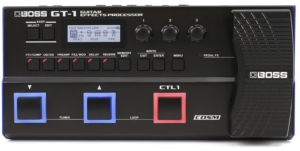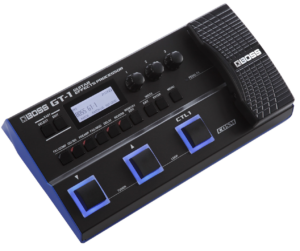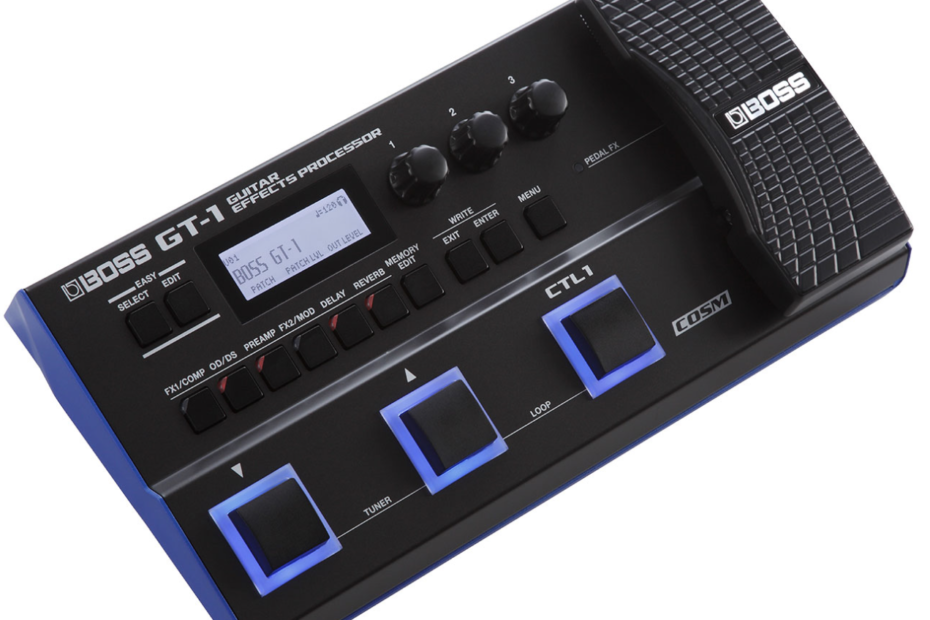The Boss GT-1 Guitar Multi-effects Pedal is a compact and versatile effects processor designed to provide guitarists with a wide range of high-quality effects, amp simulations, and tonal options in a portable and user-friendly format. It’s part of Boss’s long-standing tradition of producing multi-effects units that offer professional-grade sound processing and a diverse palette of tones.
Let’s explore the key features, capabilities, and benefits of the Boss GT-1:
Compact and Portable: The Boss GT-1 is designed to be lightweight and compact, making it easy to carry and transport. Its small size is ideal for gigging musicians who require a versatile effects solution without the bulk of larger pedalboards or multi-effects units.
Extensive Sound Library
 The GT-1 boasts a wide variety of effects and amp simulations, including overdrive, distortion, delay, reverb, modulation, and more. With 108 different effects types and 99 preset patches, the pedal covers an array of genres and playing styles.
The GT-1 boasts a wide variety of effects and amp simulations, including overdrive, distortion, delay, reverb, modulation, and more. With 108 different effects types and 99 preset patches, the pedal covers an array of genres and playing styles.
The Boss GT-1’s Sound Library is a comprehensive collection of high-quality effects, amp models, and presets designed to provide guitarists with a diverse palette of tones for various musical styles. This extensive library allows you to explore a wide range of sounds, from classic to contemporary, and create custom patches to suit your unique playing preferences. Let’s delve deeper into the GT-1’s Sound Library:
1. Effects: The Sound Library of the Boss GT-1 includes an array of effects categories, each containing a variety of effect types. These effects can be applied individually or combined to create rich and intricate sounds. Some of the effect categories you can expect to find include:
- Distortion/Overdrive: A selection of different distortion and overdrive models, ranging from mild crunch to high-gain saturation.
- Modulation: Chorus, flanger, phaser, and other modulation effects for adding movement and depth to your sound.
- Delay: Various delay types, including digital, analog, and tape delay, for creating echoes and spatial effects.
- Reverb: Different reverb algorithms to add ambience and dimension to your tone.
- Wah and Pitch: Control the pedal’s built-in expression pedal for wah-wah effects and pitch modulation.
2. Amp Modeling: The GT-1’s Sound Library includes a wide range of amp models based on classic and modern amplifiers. These amp models capture the distinct tonal characteristics and nuances of iconic amps, allowing you to dial in tones that span various genres. You might find models inspired by vintage tube amps, modern high-gain stacks, and everything in between.
3. Preset Patches: The GT-1 comes with a selection of factory preset patches created by Boss’s sound designers. These presets serve as starting points for exploring different tones and effects combinations. They cover a broad spectrum of musical styles, from clean and jazzy tones to heavy rock and metal sounds.
4. Customization and User Patches: In addition to the factory presets, the GT-1 allows you to create and save your own custom patches. This feature empowers you to tailor the Sound Library to your specific preferences and musical requirements. You can mix and match effects, amp models, and settings to craft your ideal tones.
5. Tone Studio Software: To further enhance your customization options, the Boss GT-1 Guitar Multi-effects Pedal is compatible with Boss’s Tone Studio software. This software provides a visual interface for deep editing and patch management. You can adjust parameters, reorder effects, and fine-tune your patches using your computer. The Tone Studio software expands your access to the Sound Library and simplifies the editing process.
6. Genres and Musical Styles: The GT-1’s Sound Library is designed to cater to a wide range of musical genres and playing styles. Whether you’re into blues, rock, metal, jazz, pop, country, or any other genre, you’ll find the tools you need to shape your sound according to your artistic vision.
Also Read:
BOSS CS-3 Compressor Pedal for Guitar – Review
Looping with BOSS RC-3 Loop Station
Guitar Synthesizer: BOSS SY-1 Pedal
LEKATO Multi Effects Guitar Pedal
Best Multi effects Pedal for Guitar: Review
Amp Modeling and Cabinet Simulation
 One of the standout features of the GT-1 is its amp modeling capabilities. It offers a range of amp simulations based on classic and modern amplifiers, allowing you to access different amp sounds without needing the actual amps. Additionally, the pedal includes cabinet simulation, mimicking the sonic characteristics of various speaker cabinets for an authentic tone.
One of the standout features of the GT-1 is its amp modeling capabilities. It offers a range of amp simulations based on classic and modern amplifiers, allowing you to access different amp sounds without needing the actual amps. Additionally, the pedal includes cabinet simulation, mimicking the sonic characteristics of various speaker cabinets for an authentic tone.
Intuitive Interface: The GT-1 features an intuitive and user-friendly interface with dedicated knobs and buttons for easy parameter adjustment. The LCD screen displays patch information, effect settings, and other relevant details, enhancing the pedal’s usability.
Expression Pedal: The built-in expression pedal allows you to control various parameters in real time, such as volume, wah, and pitch. This adds an expressive dimension to your playing and opens up creative possibilities.
Looper Functionality: The pedal includes a built-in looper, enabling you to record and play back loops for practice, composition, and live performance. The looper has up to 32 seconds of recording time.
USB Connectivity and Editing Software: The pedal can be connected to a computer via USB, allowing you to use Boss’s Tone Studio software. This software provides in-depth editing capabilities, making it easier to customize your patches and effects settings on your computer.
Battery or AC Power: The pedal can be powered using either four AA batteries or an AC adapter, providing flexibility for both on-the-go and studio use.
Patch Customization: In addition to the preset patches, the pedal allows you to create and save your own custom patches, enabling you to craft your ideal tones.
Versatility and Performance: The pedal is suitable for a wide range of musical genres and playing styles. Whether you’re a beginner looking to experiment with effects or a professional musician seeking a compact and reliable effects solution, the GT-1 delivers versatility and performance.
Using the GT-1

Using the Boss GT-1 Guitar Multi-effects Pedal involves several steps, from basic setup to creating and modifying patches. Here’s a general guide on how to use the pedal effectively:
1. Basic Setup:
- Ensure the GT-1 is powered using either four AA batteries or an AC adapter.
- Connect your guitar to the INPUT jack of the pedal using a standard guitar cable.
- Connect the OUTPUT jack of the pedal to your amplifier or audio interface.
- Turn on the pedal using the power switch.
2. Selecting Patches:
- Use the rotary knob to scroll through the available patches. You can select a patch that best suits your playing style or the song you’re playing.
- Press the footswitches to toggle the effects on or off within a patch.
3. Adjusting Parameters:
- Once you’ve selected a patch, you can tweak its parameters using the knobs on the pedal’s interface.
- Each knob corresponds to a specific effect parameter (e.g., gain, tone, level). Turn the knobs to adjust the effect’s settings to your preference.
4. Using the Expression Pedal:
- The Boss GT-1 Guitar Multi-effects Pedal has an expression pedal that you can use to control various effects in real time, such as volume, wah, and pitch modulation.
- To use the expression pedal, assign it to the desired effect parameter. For example, you can assign it to control the volume level or the wah effect.
5. Creating and Modifying Patches:
- To create a new patch, start with an existing one that’s close to the sound you want. Press and hold the CTL pedal, then use the rotary knob to select an empty patch slot. Release the CTL pedal.
- Modify the patch by adjusting the effect parameters, amp settings, and other parameters using the knobs and buttons on the pedal.
- Press and hold the memory button (WRITE) to save your changes to the patch. Use the rotary knob to select a memory location, then press the WRITE button again to confirm.
6. Accessing Additional Functions:
- The GT-1 pedal offers various functions accessible through different button combinations. Refer to the user manual to learn how to access features like the tuner, tap tempo, looper, and more.
7. Using Boss Tone Studio:
- Connect the GT-1 to your computer using a USB cable.
- Download and install the Boss Tone Studio software from the Boss website.
- Open the software to access in-depth editing options, including customizing effect chains, amp models, and more. You can also download additional patches created by other users.
8. Performance and Practice:
- Experiment with different patches to find the tones that work best for your playing style and musical genre.
- Use the looper function to record and practice over chord progressions or create layered soundscapes.
